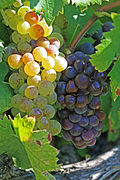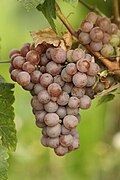Grape

Any of numerous woody vines of genus Vitis bearing clusters of edible berries .
A vine fruit, and the only one from which experts accept real wine can be made. There are thousands of varieties of grapes, some for eating and others for wine production. Wine grapes are known as varietals - Chardonnay, Cabernet Sauvignon and so on.
Brandy and other spirits are based on grapes.
Common Grapes Guide:
VITIS VINIFERA
Vitis vinifera is the classic family of wine grapes and includes such renowned varietals as Zinfandel and Chardonnay. The vines originated in what's now southwestern Russia. In the United States, v. vinifera now thrives in California and the Pacific Northwest, and also does well in microclimates scattered from the Mid-Atlantic to the Midwest. V. labrusca is a family of vines that's native to North America. These vines are more hardy and disease-resistant than v. vinifera, but aren't quite as ideal for making wine. Hybrids, also called French-American hybrids, are a cross between v. vinifera and v. labrusca. Hybrids can produce excellent wines; they combine the superior wine-making qualities of v.vinifera with the toughness of v. labrusca. Below is a quick guide to some common wine grapes.
Whites
Pinot Grigio
Also known as Pinot Gris, this fine Italian varietal lends itself well to dry, acidic, crisp styles.
Grown around the globe with the "spicy" full-bodied Alsatian and lighter-bodied, more acidic Italian styles being most widely recognized. The Alsatian style, often duplicated in New World wine regions such as Marlborough, Tasmania, South Australia, Washington, and Oregon, tend to have moderate to low acidity, higher alcohol levels and an almost "oily" texture that contributes to the full-bodied nature of the wine.
The flavors can range from ripe tropical fruit notes of melon and mango to some botrytis-influenced flavors.
Pinot Blanc

A traditional white wine grape of Burgundy. It is a point genetic mutation of Pinot noir. Pinot noir is genetically unstable and will occasionally experience a point mutation in which a vine bears all black fruit except for one cane which produces white fruit.
Pinot Blanc is a subtle varietal that should be gently taken through a cool fermentation and then barrel aged.

Muscat
The Muscat family of grapes (which inclues Orange Muscat, Muscat Canelli and Muscat de Frontignan) all exhibit heady floral aromas while packing a strong fig-guava punch.
The Muscat family includes over 200 grape varieties belonging to the Vitis vinifera species that have been used in wine production and as raisin and table grapes around the globe for many centuries. Their colors range from white (such as Muscat Ottonel), to yellow (Moscato Giallo), to pink (Moscato rosa del Trentino) to near black (Muscat Hamburg). Muscat grapes and wines almost always have a pronounced sweet floral aroma. The breadth and number of varieties of Muscat suggest that it is perhaps the oldest domesticated grape variety, and there are theories that most families within the Vitis vinifera grape variety are descended from the Muscat variety.
Gewürztraminer

Typically thought of as a German varietal, this grape actually originated in northern Italy. It is often made in sweet or off-dry styles this is one grape that most wine lovers would immediately flag in a blind tasting because it is so distinctive.
Alsace is its home and it produces some rich tapestry of fruity, floral, and spicy tastes. Its texture can be characterized as rich and smooth. Like the Riesling, it can be harvested late to produce classy wines. But be really careful when matching Gewurztraminer with food.
It's an exciting stand alone wine, but not a high-odds proposition at your table.
Riesling

Laden with floral, apricot and peach notes, Riesling makes wonderful sweet as well as dry wines - all aromatic and lush in aroma and flavor.
Its homeland is Germany, where it has been cultivated since the 1400s. It has a strong personality being highly acidic, yet very adaptable. But it is not a grape that everyone takes an instant liking to. One of the most recognizable features in a Riesling is its styles ranging from dry to richly sweet. Young Riesling wines can smell like peaches, mint, lime, and honey but as they age they begin taking on gasoline like tones.
Chardonnay
Often called the "King of the White Varietals," Chardonnay has never been more popular among wine consumers. When crisp, bright and judiciously oaked, Chardonnay lives up to its royal title. The Chardonnay grape variety is a classic white wine grape and grown all around the world. It typically smells like apples, lemons, peaches, and tropical fruits. The berries are relatively small, thin-skinned, fragile, and oxidize easily. This makes chardonnay somewhat more sensitive to winemaking techniques and more difficult to handle from harvest to bottling than most other grape types.
Chardonnay also ages well in the bottle, though it will not age as long as many red wines. With its relatively high acids, full-bodied nature and incredible versatility, Chardonnay can be enjoyed alone or with a wide variety of flavorful dishes.
Sauvignon Blanc

The "Other Chardonnay" is a native of the Bordeaux region of France. Sauvignon Blanc is relatively easy to make and can range from grassy and vegetal to fruity and floral. It is often fermented cold and not barrel aged.
This white grape produces wines that are popular around the world, sometimes known simply as "Sauvignon". It is responsible for many of France's great white wines. One of Sauvignon Blanc's greatest qualities is its incredible adaptability in the vineyard. Sauvignon Blanc has distinct and recognizable characteristics. Aroma and flavor descriptors include flavors of grass, gooseberries and asparagus. Young wines may have green tinge and aged wines can present deep yellow and golden.
Reds
Syrah
The Syrah grape originated in Asia Minor where it was called the "Shiraz" grape, as it still is in Australia and South Africa. Syrah makes up the primary red wines of the Rhone Valley of France and can make for lush, berry-cherry wines or spare, truffle-earthy wines.
Syrah is one of the greats of southeastern France's Rhone Valley grape. At home in France, it produces wines that are smoky, herby, and austere. Australian Shiraz tends to be richer, softer with a leathery quality and personally one of my favorites.
All Syrah/Shiraz need a year or two from the vintage to hit its stride. Top wines will last about ten years.
Zinfandel

Zinfandel is one of the most popular grapes grown in California and is known for its robust tannins, well-rounded aromas and lush flavors. Jammy, berry, fruit and black pepper are the most common descriptors.
It is disputable where this grape originated, but it is indisputably California's grape today, with almost no winemakers in other places producing it. The best Zinfandel is spicy and heartwarming. Other styles range from off white to high intensity sweet wines. Try a bottle not more than three or four years old, because that's when the Zinfandel character is strongest.
Sangiovese

The superstar of the Tuscan winemaking scene, Sangiovese takes a long, warm growing season to produce the best fruit, redolent of truffles, blackberries and black currants. A taste of Sangiovese and you will immediately conjure images of Italy.
The name of the grape may not seem familiar, but it is the principal variety behind Chianti, Italy´s most famous red wine. It is taken very seriously in Tuscany, and you will find it in California, Australia, and Argentina. It is naturally tannic and is best used in a blend, usually with Cabernet Sauvignon. It requires a hot climate in order to produce its required richness and alcohol content. In cooler climates, it tends to have sharp and bitter tannins.
Cabernet Sauvignon
Cabernet Sauvignon is the big daddy of the red wine world and perhaps the most famous grape varietal in the world. California's best red wines often are made of this grape, which is suprisingly easy to grow and make into wine. Cabernet Sauvignon is like the Chardonnay, as it is widely planted and distributed. The result of this is that there are so many versions of this grape. Many people think of Cabernet Sauvignon as being a wine that needs to age, but that is only because the best red Bordeaux need age. Most non-premium varieties are ready to go right away.
Under ideal conditions, it produces an aromatic, tannic wine that ages and evolves to be both elegant and powerful. Perfectly balanced Bordeaux is one that has classic notes of black-currants,blackberry jam,cedar,cigar boxes,bell pepper,pencils,mint and dark chocolate.
Merlot
Merlot is the most important grape varietal grown in Bordeaux and forms the backbone of many "meritage" (Bordeaux-style) blends. It is similar to Cabernet Sauvignon, but displays more fruity than herbaceous or vegetal character.
Merlot started out as a Cabernet Sauvignon in Bordeaux and has risen to international popularity. The great wines of Pomerol and St. Emilion in Bordeaux are based on Merlot with Cabernet in the blend. These wines show Merlot at its toughest and most intense. Merlot´s popularity is because it is softer, fruitier, and earlier maturing than Cabernet Sauvignon and displays some of the same aromas along with mint, and tobacco. In general, drink Merlot young.
Pinot Noir
Burgundy's most important red grape varietal, Pinot Noir has become a sort of Holy Grail for winemakers of late. It is a very difficult wine to get right. Its brambleberry and coffee aromas often show their best in the most expensive cool-climate fruit.
At its best Pinot Noir is beautiful with a seductive silky texture and at its worst, it is heavy or flat. A good mature Pinot Noir has complex flavors of strawberries, raspberries, cranberries, violets, all-spice, tobacco and hay. Pinot Noir is relatively low in tannin and acidity and needs a cool climate to grow. Provided too much warmth, Pinot Noir can develop baked together flavors, losing its elegance.
VITIS LABRUSCA
Whites
Niagara
Known for its heady, heavily-scented wine, Niagara is a varietal grown for the bottle as well as for eating.
Catawba
Hearty and productive, well-established in American winemaking history, Catawba tends to ripen late. So it often has inadequate sugar levels.
Reds
Concord
Concord is most famous for being the "grape juice" grape. It's also most likely to end up in a jam or jelly jar! Concord's distinctive grape-juice aroma renders it only suitable for winemakers who enjoy this element in their wines.
Delaware
Small clusters and pink-skin berries distinguish this grape. When treated correctly, it can rival the aromatic and perfumed off-dry wines of Alsatian France and Germany.
Ives
Not very resistant to cold or disease, Ives may be on the way out these days. But for decades, it was - and still is - known for port-style red wines.
HYBRIDS
Whites
Seyval Blanc
This hybrid can compete with some of the finest dry white wines made from Chardonnay and Chenin Blanc.
Vignoles
With a delicate floral aroma, this white varietal has won many commercial and amateur winemaking contests.
Vidal Blanc
Vidal Blanc is often used in late-harvest dessert wine styles but must be watched carefully in the vineyard. If left to ripen too long into a damp, early winter, mildew and bunch rot are quite likely to develop.
Reds
Marechal Foch
An early ripener with cranberry-currant flavors and a bright red color.
Chancellor
Quite tannic and known for its plum-cedar aroma, this grape is susceptible to powdery mildew and must be carefully scrutinized before crushing.
Chambourcin
Possibly the most abundantly planted red hybrid varietal, Chambourcin has blue-black berries with cherry-berry aromas.